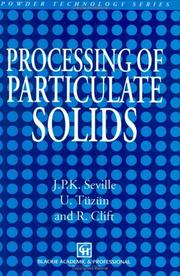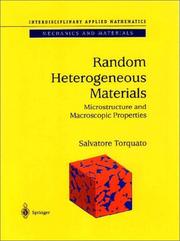| Listing 1 - 3 of 3 |
Sort by
|

ISBN: 3446175946 1569901686 Year: 1994 Publisher: Munich Hanser
Abstract | Keywords | Export | Availability | Bookmark
 Loading...
Loading...Choose an application
- Reference Manager
- EndNote
- RefWorks (Direct export to RefWorks)
678-4 --- #TWER:BOEK --- assemblage --- assemblage-gericht ontwerpen --- industrieel ontwerpen --- kunststof --- matrijsontwerp --- sterkteleer --- technische kunststof --- 688 --- kunststofdelen ; ontwerpen --- kunststoffen --- kunststoffen ; assembleren --- 678-4 State, condition, form of materials --- State, condition, form of materials --- Physicochemistry --- Organic chemistry --- Materials sciences --- Non-cutting processes --- Materials processing --- Production management --- Plastics --- organic chemistry --- DFA (design for assembly) --- organische chemie --- productontwikkeling --- fysicochemie

ISBN: 0751403768 9401071527 9400914598 9780751403763 Year: 1997 Publisher: London Blackie academic and professional
Abstract | Keywords | Export | Availability | Bookmark
 Loading...
Loading...Choose an application
- Reference Manager
- EndNote
- RefWorks (Direct export to RefWorks)
Over half of the products of the chemical and process industries are sold in a particulate form. The range of such products is vast: from agrochemicals to pigments, from detergents to foods, from plastics to pharmaceuticals. However, surveys of the performance of processes designed to produce particulate products have consistently shown inadequate design and poor reliability. `Particle technology' is a new subject facing new challenges. Chemical and process engineering is becoming less concerned with the design of plants to produce generic simple chemicals (which are often single phase fluids) and is now more concerned with speciality `effect' chemicals which may often be in particulate form. Chemical and process engineers are also being recruited in increasing numbers into areas outside their tranditional fields, such as the food industry, pharmaceuticals and the manufacture of a wide variety of consumer products. This book has been written to meet their needs. It provides comprehensive coverage of the technology of particulate solids, in a form which is both accessible and concise enough to be useful to engineering and science students in the final year of an undergraduate degree, and at Master's level. Although it was written with students of chemical engineering in mind, it will also be of use and interest to students of other disciplines. It comprises an account of the fundamentals of teh subject, illustrated by worked examples, and followed by a wide range of selected applications.
66-4 --- Particles. --- 62-492.2 --- 62-492.3 --- Size of particles --- Clay --- Colloids --- Sand --- Soils --- State, condition, form of materials etc. in chemical technology --- Pulverous material. Powders. Dusts --- Granular material. Grains. Granules. Shot. Grit --- Basic Sciences. Biotechnology --- Biotechnology (General) --- Biotechnology (General). --- 62-492.3 Granular material. Grains. Granules. Shot. Grit --- 62-492.2 Pulverous material. Powders. Dusts --- 66-4 State, condition, form of materials etc. in chemical technology --- Particles --- Industrial engineering. --- Production engineering. --- Materials science. --- Biotechnology. --- Engineering design. --- Industrial and Production Engineering. --- Characterization and Evaluation of Materials. --- Engineering Design. --- Design, Engineering --- Engineering --- Industrial design --- Strains and stresses --- Chemical engineering --- Genetic engineering --- Material science --- Physical sciences --- Manufacturing engineering --- Process engineering --- Industrial engineering --- Mechanical engineering --- Management engineering --- Simplification in industry --- Value analysis (Cost control) --- Design --- Grammar, Comparative and general Particles --- Grammar, Comparative and general --- Function words

ISBN: 0387951679 9780387951676 1475763573 1475763557 Year: 2002 Volume: v. 16 Publisher: New York Springer
Abstract | Keywords | Export | Availability | Bookmark
 Loading...
Loading...Choose an application
- Reference Manager
- EndNote
- RefWorks (Direct export to RefWorks)
The study of random heterogeneous materials is an exciting and rapidly growing multidisciplinary endeavor. This field demands a unified rigorous means of characterizing the microstructures and macroscopic properties of the widely diverse types of heterogeneous materials that abound in nature and synthetic products. This book is the first of its kind to provide such an approach. Emphasis is placed on foundational theoretical methods that can simultaneously yield results of practical utility. The first part of the book deals with the quantitive characterization of the microstructure of heterogeneous materials. The second part of the book treats a wide variety of macroscopic transport, electromagnetic, mechanical, and chemical properties of heterogeneous materials and describes how they are linked to the microstructure of model and real materials. Contemporary topics covered include the statistical mechanics of many-partical systems, the canonical n-point correlation function, percolation theory, computer-simulation methods, image analyses and reconstructions of real materials, homogenization theory, exact property predictions, variational bounds, expansion techniques, and cross property relations. This clear and authoritative volume will be of particular interest to graduate students and researchers in applied mathematics, physics, chemistry, material sciences, engineering, geophysics, and biology. Moreover, the book is self-contained and approachable by nonspecialist. Salvatore Torquato is a professor in the Department of Chemistry and in the Materials Institute at Princeton University. He also holds affiliated appointments at Princeton University in applied and Computational Mathematics Program and in Chemical Engineering. Among other honors, he was a John Simon Guggenheim Fellow in 1998. He has published over two hundred journal articles across a variety of scientific disciplines.
Statistical physics --- Mathematical statistics --- Fluid mechanics --- Inhomogeneous materials. --- Microstructure. --- Materiaux hétérogènes --- Microstructure (Physique) --- 62-4 --- 541.68 --- 531.19 --- 539.219.1 --- Materials --- Matter --- Morphology --- Micromechanics --- Stereology --- Heterogeneous materials --- Inhomogeneous media --- Media, Inhomogeneous --- State, condition, form of materials, surfaces, objects, products --- Relation of chemical structure to mechanical properties --- Statistical mechanics --- Irregularities. Impurities. Inclusions. Heterogeneity. Streaks. Gas emission --- Constitution --- 539.219.1 Irregularities. Impurities. Inclusions. Heterogeneity. Streaks. Gas emission --- 531.19 Statistical mechanics --- 541.68 Relation of chemical structure to mechanical properties --- 62-4 State, condition, form of materials, surfaces, objects, products --- Materiaux hétérogènes --- Inhomogeneous materials --- Microstructure --- Probabilities. --- Materials science. --- Mechanical engineering. --- Statistical physics. --- Dynamical systems. --- Condensed matter. --- Probability Theory and Stochastic Processes. --- Materials Science, general. --- Mechanical Engineering. --- Complex Systems. --- Condensed Matter Physics. --- Characterization and Evaluation of Materials. --- Condensed materials --- Condensed media --- Condensed phase --- Materials, Condensed --- Media, Condensed --- Phase, Condensed --- Liquids --- Solids --- Dynamical systems --- Kinetics --- Mathematics --- Mechanics, Analytic --- Force and energy --- Mechanics --- Physics --- Statics --- Engineering, Mechanical --- Engineering --- Machinery --- Steam engineering --- Material science --- Physical sciences --- Probability --- Statistical inference --- Combinations --- Chance --- Least squares --- Risk --- Statistical methods
| Listing 1 - 3 of 3 |
Sort by
|

 Search
Search Feedback
Feedback About UniCat
About UniCat  Help
Help News
News